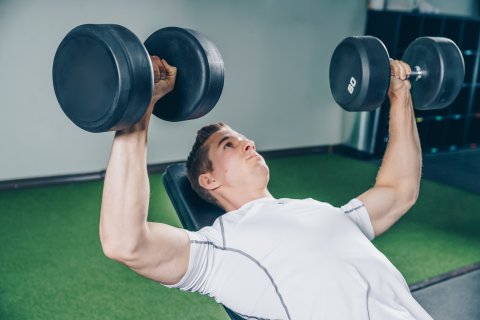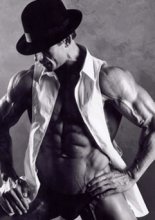You are here
Home ›Principles of Weight Training
 Q: Dear Cory, I know weight training plays an important role in fitness, health and strength training. I’ve heard and read many theories pertaining to how I’m supposed to train. Could you explain some of the principles that you use yourself in gym and share how they helped you win the Canadian Masters Natural Bodybuilding Championships?
Q: Dear Cory, I know weight training plays an important role in fitness, health and strength training. I’ve heard and read many theories pertaining to how I’m supposed to train. Could you explain some of the principles that you use yourself in gym and share how they helped you win the Canadian Masters Natural Bodybuilding Championships?
A: This requires no less than a three-part answer. Weight training is an art form which requires tremendous skill, coordination, and great mental concentration. That’s if you do it right. Millions of people world wide are lifting weights but how many of them really understand what they are doing? How many are getting the results they want? How many have been professionally trained?
Part One
For sure the 80/20 rule applies here. Eighty percent of gym members cross North America do not really know what they’re doing. Just take a look a how people bench or perform lateral raises. Few men work their legs with equal devotion and time compared to their arms or chest, and core training, which involves working the entire region of the trunk and midsection, front and back, is seldom made a priority, even though it’s the power center of the body. Remember, it’s impossible for an athlete to transfer their full potential power in sport without a strong, tight gut.
In weight lifting, strict attention must be applied to correct execution of movements and proper exercise form. Prevention of injury and the long-term effect of your exercise strategy must be a consideration associated with choosing specific exercises. Like throwing the hammer or discus in track and field, technique is everything.
Bent-over barbell rowing is excellent for building the latissimus dorsi and rhomboideus major, but with heavy weights this exercise can ruin the vertebrae in the column of your lower back, no matter how good your technique is. Most competitive powerlifters and many bodybuilders for example, end up with chronic back pain, are forced to have surgery, and become susceptible to arthritis and related auto-immune disorders that involve inflammation. It all starts with how you begin, and like everything, it’s important to examine your motives.

Behind neck presses are another good example. They’re well known for building massive shoulder strength, but thousands of athletes destroy their joint capsule and damage their rotator cuff muscles in the process. In the end they learn to live with chronic shoulder pain or even worse, quit training all together. It is illogical to damage the body in the process of building muscle or developing strength. I recommend reading The New Power Program by Dr. Michael Colgan. It will give you a good perspective on training do’s & don’ts.
Learning basic movements like barbell squats or the bench press takes time, energy and lots of practice. In weight training, repetition is the mother of skill. Each rep should be performed with precision and know how. Consideration of your skeletal structure and overall physical health is very important before engaging in a workout program. Begin with basic exercises using light weights, a repetition range of say 12-20 with moderate intensity.
Initially, the amount of weight you use is irrelevant. Drop the ego (not the weights!). Develop the right lifting pattern first. Focus on exercise technique and develop a rhythmic pattern of breathing and muscle control. By using your muscles according to their design you will definitely become more sensitive to your personal form & function and aware of ‘yourself’.
Avoid jerky, fast movements. Push or pull against resistance in a controlled and relatively slow fashion. Concentrate mentally on the fibers and muscle group you are forcing to contract in response to your telepathic command. Become aware of how the exercise ‘feels’. Although the motion of each exercise may seem foreign or uncomfortable in the beginning, the movements will eventually feel natural and smooth - the cable, dumbbell or barbell should become an extension of your limbs and mind. Gradually you’ll develop an instinctual awareness of yourself and eventually what is known as the mind-muscle connection.
When performing any exercise, there is a general tendency to ‘slack off’ or compromise exercise technique to make the exercise easier. This is a natural response, as the body if left to itself, will always choose the pathway of least resistance to conserve energy. It’s called ‘going through the motion’. This tendency however, reduces the productivity of the exercise and greatly limits muscular development and most of the physical benefits related to training. Every conscious attempt should be made to stay true to correct exercise form, with all effort focused on making the exercise as difficult as possible, and therefore more productive. Rest between sets, not during sets.
For training purposes, the body can be categorized into six primary or basic muscle groups according to size, including legs, back, chest, shoulders, triceps and biceps. Secondary muscle groups include traps, hamstrings, calves, forearms, lower back and abs or what is known as your core.
Two major types of resistance exercises are typically employed:
The first is known as a Compound Movement
Compound movements target large or primary muscle groups and recruit smaller secondary muscles. A good example is the bench press. Although the chest is the target, the deltoid and tricep muscles are also recruited and forced to contract when the bar is lowered and raised, thus receiving stimulation. I bench with my feet off the floor and flat on the bench, and never lift my butt off to ‘cheat’ the weight up. Except in rare cases when cheating is applied as a principle in advanced lifting, cheaters never prosper in the gym.
The short term gain is ALWAYS superceded by long-term loss of health & function. Compound movements are foundation exercises and are great for building size and strength. Some examples are chin-ups, bar-dips, standing barbell curls, squats, deadlifts, military press, power cleans, bench press and so on.
The second basic type of free-weight exercise is called an Isolation Movement
Isolation movements target one muscle group only (relatively speaking). A good example is a concentration bicep curl using a dumbbell or tricep extensions using a cable or e-z-curl bar. Isolation exercises supplement compound movements and can be very useful for working around injuries, developing sport specific functional value or targeting specific muscle fibers after performing a major compound exercise.
Most weight-training routines combine compound and isolation movements using free weights, cables, and machines. Each individual is built differently and responds uniquely to a variety of exercises; therefore, through trial and error one must discover ones’ own ideal training routine and exercise format blend.
Complete range of motion and continuous tension are two important principles of modern weight training. While engaged in any particular exercise, one should concentrate on full range of muscular motion in relation to the function and natural movement of the target muscle. This means you should fully extend and completely contract the muscle.
Complete stretch and maximum contraction with applied resistance and control of movement is necessary for total muscular development. Partial movement brings only partial results, although partial movements may be utilized in heavier lifting techniques to increase tendon and ligament strength, or enhance one's adaptive capacity to accommodate heavier lifting strategies.
But these are reserved once again for advanced lifting strategies and shouldn't be employed until one has mastered the basic principals first (and even then their practice is questionable).
Continuous tension relates to maintaining pressure or tension on the muscle without allowing it to rest or relax through its fullest range of motion. Resting the muscle while performing the exercise is not recommended. For example, at the top of the squat it is possible to lock the knees and remove the tension from the quadriceps. Avoid this temptation. Ascend just to the point of near lock-out at the top and then descend back down with control. Breathe in as you lower the weight – the oxygen is vital to the explosive phase. Avoid dropping down quickly. The eccentric or negative phase of lifting is actually the most important phase. As you lower the weight in the squat, resist the weight and lower your body in a controlled fashion. Then just as you break parallel, explode upwards with the force of a mountain. Exhale as you drive the weight up. Always maintain control of the weight, don’t let it push or pull you around.
Photo by Oren Yomtov from Burst
Principles of Weight Training: Part Two
Principles of Weight Training: Part Three

As always, stay well and live free!
Dr.C
- Log in to post comments